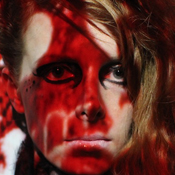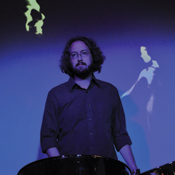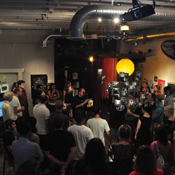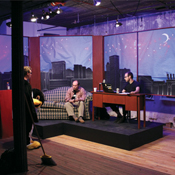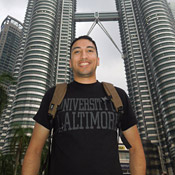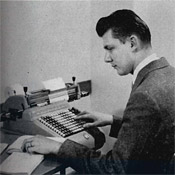Highlighted Class Note: EMP Collective
Category: WebExtras
Short movies. Theater pieces. Gallery shows. Writing workshops. You could call it artistic manifestation in every form. But for the EMP Collective, it’s about not only quality work, but also what the group hopes to inspire in other area artists of all kinds.
We spoke with the organization’s founders in October to find out more about the impact this quirky, all-volunteer team of actors, artists, writers, filmmakers and musicians has had on the local arts scene.
UB: Tell me about EMP Collective. When and why did you decide to found it?
Cartwright: Several EMPs (a term Cartwright uses to describe the group’s members and friends), including Maggie, Carly [J. Bales], Ken [Jordan], Nolan [Cartwright, Brad’s brother] and I, all met in Tallahassee, Fla., where most of us [had] earned undergraduate degrees at Florida State University. In 2007, we put on an evening of short plays that we had written called Half Pint Night. We were all about mixing media from the start. The show was emceed by our spiritual guru of sorts, a radio personality named Hearty White. We performed at our friend’s art gallery in Railroad Square and had local bands play the after-party (including my band, Kid Hart).
Shortly after our first production in 2007, Maggie was offered a job at [the] Baltimore Opera Company, so we moved up to Baltimore.
Villegas: Which is where I met Katy. She was the box office manager, and I was the assistant stage and production manager. The opera company folded after the fall season in 2008, and Carly had just moved to D.C. We’d been talking about producing another show together, and finally our stars were starting to align.
In January 2010, we produced our first event as EMP—We’re All Gonna Die!—at the Lumberhaus in Station North. After the last performance, we all sat around in a circle and asked each other, “What’s next?” That’s when we decided to form a nonprofit.
UB: Does it fill a particular niche you felt was missing in Baltimore?
Villegas: I’ve always felt that Baltimore was so alive artistically, so it’s tough to say. The awkward “we want to do everything” niche, maybe?
Cartwright: EMP’s niche is everything. From the beginning, we enjoyed testing ourselves by going outside of our disciplinary comfort zones. We really wanted to focus on creating those same opportunities for young artists.
UB: Describe the artistic experience you provide. What genres does the organization cover—or, perhaps more appropriately, what genres doesn’t it cover?
Villegas: We’re up for anything. A lot of our projects start with “Wouldn’t it be cool if ... ?” and “Yes.” We produce films, writing, theater, music, gallery shows and everything in between. And the bulk of our programming to date has somehow [involved] integrated media. We’re big fans of keeping our shows as experiential as possible, from the moment you walk in to the moment you leave; we like to put you in that world from the get-go.
Dubina: We have a couple goals whenever we sit down to think about what we’re going to do next. We want to collaborate and learn from each other. We want to make sure that we’re giving young artists the chance to experiment, develop and show new work. And we want to give artists the chance to work in mediums that they wouldn’t ordinarily work in.
UB: What have been your most successful EMP Collective endeavors so far?
Villegas: Yikes! Hard to say. I’m proud of us for running a venue. We’re all volunteers and we do a lot of programming, and I think we’ve done a really great job of working together to make things happen—even if some of it has involved a fair share of nail-biting.
Cartwright: Prior to having a permanent home, too much of our energy and overhead went into scouting and renting locations. Creatively speaking, finding a home freed us up to focus on our crazy ideas. We’ve all worked really hard so that no matter the event, the audience has a quality experience. We like to keep them guessing, anxious to see what sort of fun they’ll walk into the next time they visit EMP.
UB: The City Paper recently named EMP Collective the “Best Collective,” you’ve been featured everywhere from the Urbanite to Baltimore magazine and WJZ, and you also mentioned receiving an award from the Downtown Partnership of Baltimore Oct. 4. Why do you think you’ve been so successful in the relatively short time since you started this organization?
Villegas: We work really hard and are generally nice to people. I think that our inclusionary approach to things is appealing. We say “yes” a lot.
UB: You’ve made a point to partner with other local organizations and with local and visiting artists. You even solicit project proposals on your website and offer free workshops. What’s your goal in doing so? Is this an unusual effort for an organization like yours?
Villegas: We want people to create. That’s a big deal to us. So we want to give as many opportunities to do so as possible. Why don’t people write half the time? They don’t have a deadline. Give them the chance to be in a workshop that doesn’t cost them anything, and they’ll write.
Cartwright: We know how hard it can be to work with others who have a vision, and we know how logistically difficult and expensive it is to find a location for an event. We do our best to show our appreciation with collaborators, and we go out of our way to accommodate our guests’ needs. We’d hope that these efforts aren’t considered unusual.
UB: What do you see as your role in the continuing redevelopment of Baltimore’s west side?
Villegas: Our hope is to continue to build relationships in the community and collaborate with other local arts groups to grow the west side as a destination.
We acquired our space on the west side through the Downtown Partnership’s Operation Storefront project back in October 2011. It was an initiative that placed small, startup businesses in temporary vacant [buildings] to help activate the streets downtown. Our storefront was the only thing open on our block.
Since then, there have been a lot of exciting developments in the neighborhood. The west side recently received arts district designation [as] the Bromo Tower Arts and Entertainment District. [There’s also] a mural project called “Articulate Baltimore” along Howard Street this October. We want to help keep that momentum going.
UB: What’s next for you and for EMP Collective?
Dubina: On Oct. 1, we moved into a new space at 307 W. Baltimore St., the first floor of our previous location. We’re hosting our third round of the Cans n Drafts writing workshop, which starts Oct. 15, and we’re hosting our grand opening of the new space Nov. 2.
Our first show in the new space will be a large-scale, 20-artist wall execution of the surrealist game Exquisite Corpse.
Villegas: I’m very excited because we’ll be collaborating with both new and previous artists to help create the new space over the course of this month.
Long term, we want to grow the organization into a more sustainable model. We’ve got the supplies, we’ve got the space, now we want to work toward relieving the financial barricades artists face by increasing our ability to compensate them for their good work.
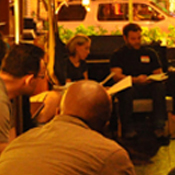
EMP Collective
Writing in Tandem readings, Cans n Drafts writing workshop, fall 2011; photos courtesy of EMP Collective
EMP Collective
Writing in Tandem readings, Cans n Drafts writing workshop, fall 2011; photos courtesy of EMP Collective
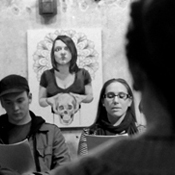
EMP Collective
Writing in Tandem readings, Cans n Drafts writing workshop, fall 2011
EMP Collective
Writing in Tandem readings, Cans n Drafts writing workshop, fall 2011
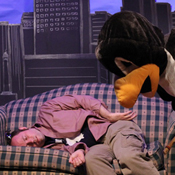
EMP Collective
a rehearsal for It’s Finally Here, EMP Collective’s late-night talk show performance, in June
EMP Collective
a rehearsal for It’s Finally Here, EMP Collective’s late-night talk show performance, in June
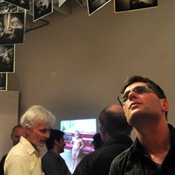
EMP Collective
The Genesis Project exhibition at the Fridge in Washington, D.C., in July
EMP Collective
The Genesis Project exhibition at the Fridge in Washington, D.C., in July
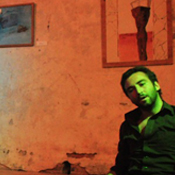
EMP Collective
Matthew Frazier-Smith of Core Project Chicago performs a dance piece in The Genesis Project in Baltimore
